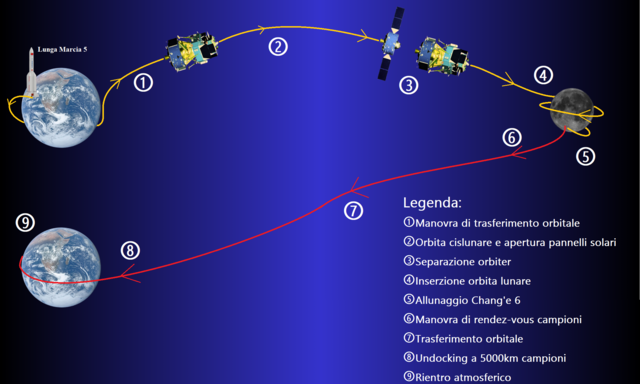China's Chang'e-6 probe has successfully returned to Earth carrying samples from the Moon's far side, concluding a technically challenging 53-day mission. This marks the first time in history that material has been collected from this less-explored region of the Moon, potentially offering new insights into its formation and geological history.
The Chang'e-6 landing module touched down at a predetermined site in Inner Mongolia at 2:07 PM local time (0607 GMT) on Tuesday, as announced by the China National Space Administration (CNSA). The mission has been hailed as a "complete success" by the CNSA, with President Xi Jinping praising the "outstanding contributions" of the mission team, which he stated "will be remembered forever by the motherland and the people."
Launched from Hainan Island on May 3, Chang'e-6 embarked on its journey to the Moon, landing in the South Pole-Aitken Basin, a vast and ancient impact crater. Over the course of its mission, the probe used a drill and robotic arm to collect soil and rock samples from a region that remains largely mysterious to scientists due to its rugged terrain, which has been less affected by ancient lava flows compared to the near side of the Moon.
This mission's success is a significant milestone for China's ambitious space program, which has seen rapid advancements under President Xi's leadership. Over the past decade, China has invested heavily in space exploration, achieving milestones such as building a space station, landing rovers on Mars and the Moon, and becoming the third nation to send astronauts into orbit. The country's space endeavors have stirred a mix of national pride and international competition, with the United States expressing concerns over China's potential military objectives in space.
The Chang'e-6 mission follows the previous Chang'e-5 mission, which collected samples from the Moon's near side. By bringing back materials from the far side, Chinese scientists hope to address fundamental questions about the geological differences between the two hemispheres of the Moon. Zongyu Yue, a geologist at the Chinese Academy of Sciences, highlighted the significance of the samples in a statement: "The samples are expected to answer one of the most fundamental scientific questions in lunar science research: what geologic activity is responsible for the differences between the two sides?"
In addition to geological samples, it is anticipated that the probe has also returned with material bearing traces of ancient meteorite impacts. This could provide further insights into the Moon's history and the broader solar system.
The landing of the Chang'e-6 probe was a highly anticipated event, with state media providing extensive coverage. Live images from the landing site showed workers approaching the capsule, planting a Chinese flag beside it, and helicopters standing by on a broad patch of flat grassland. Local residents, including farmers and herders, had been evacuated from the area ahead of the landing.
The mission has not been without controversy, however. Online misinformation spread quickly, with some social media users on China's Weibo platform seizing on the unfurling of the Chinese flag to suggest that the United States faked the Apollo Moon landings. Despite such claims, the mission has been largely celebrated within China as a testament to the country's growing capabilities in space exploration.
Looking forward, China aims to continue its ambitious space agenda. Plans are underway for a crewed mission to the Moon by 2030, with the long-term goal of establishing a base on the lunar surface. This vision aligns with broader international efforts, including NASA's Artemis program, which aims to return astronauts to the Moon by 2026.






